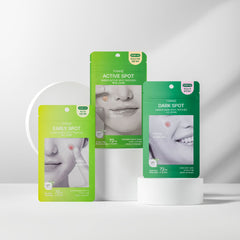Microcurrent Facial: How Often Should You Get One and Why?

In this article :
-
Microcurrent facials rejuvenate your skin without invasive procedures like Botox, filler, or facelifts. If you’re curious about trying microcurrent as part of your skincare routine, you might wonder how often you should get a microcurrent facial. The answer varies depending on where and how you are receiving the facial. If you’re doing one at home, you can typically do them more often than if you go to a professional. Read more below for everything you need to know.
-
First, what is a microcurrent facial?
-

Microcurrent facials use low electrical currents to stimulate the muscles of your face. They also promote collagen and elastin production. These two proteins are found naturally in your skin and provide structure and support.
There are many methods of getting a microcurrent facial. You can head to a professional like a dermatologist or aesthetician or use products for at-home treatments. Many microcurrent machines mimic in-office treatments, and the newest approach is a microcurrent face mask.
FRANZ Skincare has brought the power of a microcurrent facial to your home in mask form. You can tone and tighten your skin without electricity, thanks to our cutting-edge Tissue X® technology, while sending hydration and nutrients into the deepest layers of your skin.
-
Why are microcurrent treatments important?
-

Microcurrent facials have become known as the non-invasive facelift.. The treatment is natural, non-surgical, and needle-free. Microcurrent facials also require no recovery time, unlike other anti-aging beauty treatments. You can treat and go about your day.
Microcurrent treatments are like a workout for your face. Just as we work out our muscles at the gym to stay lean, a microcurrent facial keeps your skin firm, toned, and vibrant. The goal is to tighten the skin and reverse and prevent signs of aging without any surgery or pain.
-
How often should you get a microcurrent facial?
-

The recommended frequency for in-office microcurrent facials is typically every one to two months. The frequency will also depend on what’s doable for your budget and schedule — how often you can make it to your doctor’s office. However, if you're doing at-home microcurrent treatments, you can pretty much do them as often as you'd like.
For best results with the Premium Microcurrent Facial Dual Mask, use one twice a week for the first two weeks. To maintain your results after that, we recommend masking up at least once a week.
If you prefer professional visits but worrying about maintaining your skin long-term, at-home treatments are also helpful in between appointments. Enjoy the comfort of a microcurrent facial at home whenever you’d like for a fraction of the in-office cost.
Shop Microcurrent Facial Mask -
Can you do a microcurrent treatment every day?
-

For professional treatments, it’s best to complete them in a series, such as every month or every other week. There are generally no side effects from microcurrent facials. However, some might find the extra nerve stimulation from electrical microcurrent wearying. Using microcurrents too often can also overwork the facial muscles.
At-home microcurrent masks are safe for every day. You can replace your favorite evening face mask with a microcurrent mask for a professional-level facial on your couch. The only deterrent for most people is time and money. If you have time to do a microcurrent facial at home every day or every other day, go for it!
What matters most is consistency. Anti-aging is about reversing and preventing aging signs. You can do that best through a routine boost of healthy hydration and nutrients that keep your skin plump and supple. The consistent “workout” from microcurrent technology also trains your skin to remain toned and tightened for longer.
-
How long does it take to see results from a microcurrent facial?
-

Many people report noticing a difference immediately after the treatment, even if it's subtle. That being said, results get better as you complete additional facials. After a series of treatments, you'll start to have noticeable results like:
- Tighter and more toned skin
- Reduction in fine lines and wrinkles
- Slowed aging signs
- More hydrated and supple skin
- Brighter complexion
- Refined face features
For example, check out some of our microcurrent facials before and afters on this page. Keep in mind that changes might be small at first before they increase over time. It helps to take a “before” picture so that you can track your progress.
Pay attention to areas where fine lines and wrinkles are being reduced, and your muscles appear more lifted. You’ll probably also notice yourself feeling more confident going proudly makeup-free!
-
Microcurrent facial vs microinfusion
-

Both microcurrent and microinfusion are helpful facial treatments, and they are often confused. The difference is that microcurrent focuses on stimulating and strengthening the facial muscles. Microinfusion uses tiny needles to inject a skin-enhancing cocktail into your face.
Microinfusion is meant to deliver beneficial ingredients to the skin, but it remains on the superficial layer. Think about how filler can plump up your skin, but it slowly fades over time. That’s because it’s still surface-level, whereas microcurrent goes deep and focuses on the facial muscles.
-
FRANZ: where science meets nature
-


FRANZ Skincare microcurrent masks combine the best parts of microcurrent technology and microinfusion. The layered sheet masks use electricity-free technology to create gentle waves across your skin. The movement opens up your pores while stimulating the facial muscles. At the same time, the masks release anti-aging ingredients like tiny hydrating hyaluronic acid molecules, peptides to strengthen the skin layer, and ceramides to lock in moisture. It’s never too late (or too early) to start an anti-aging skincare routine that you can do long-term. We use innovative technology inspired by nature to help you look and feel your best every day. For a non-invasive facelift at home, try one of our microcurrent face masks (or neck or eye masks) here today.

